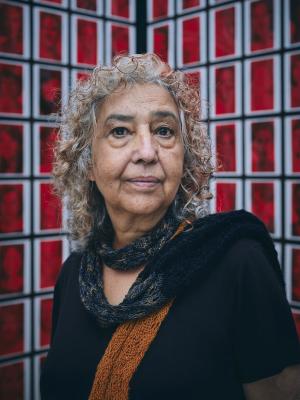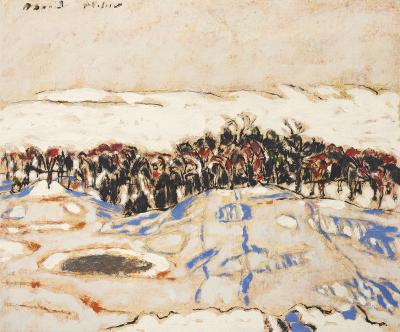Into the invisible
Journey through the mythical scenes and curious creatures in Shuvinai Ashoona’s drawings.

Shuvinai Ashoona, Compositions (Titanic Plus Nascopie & Noah's Ark), 2008. Coloured pencil with black porous point pen, graphite on paper. Sheet: 122.5 X 243 cm. Purchased with the assistance of the Joan Chalmers Inuit Art Purchase Fund, 2009. © Shuvinai Ashoona, courtesy Dorset Fine Arts. 2009/93.
Shuvinai Ashoona’s work speaks to the spiritual and fantastical dimensions of everyday life in Nunavut. Previously on view on Level 4 of the Gallery, Shuvinai Ashoona: Beyond the Visible featured 25 primarily new drawings by the third-generation Inuk artist. Curated by Wanda Nanibush, AGO Curator, Indigenous Art, the exhibition was driven by Ashoona’s confident sense of colour, sure hand and unique vision. Ashoona was awarded the Gershon Iskowitz Prize in 2018, which recognizes and supports artists in Canada. As part of that prize, the AGO invited her to show her work in a solo exhibition.
Born in 1961 in Kinngait, Nunavut (formerly known as Cape Dorset), Ashoona has been making art for more than 25 years. Like other self-taught Inuit artists living in Kinngait, she learned through observation and mentorship from more experienced artists and Elders at the West Baffin Eskimo Co-operative. She follows in the footsteps of both her parents, Kuiga (Kiugak) and Sorosilutu, as well as her grandmother Pitseolak, one of the most world-renowned and celebrated Inuk illustrators. Ashoona began drawing in 1996 and uses pen and ink, coloured pencils and oil sticks, conjuring meticulously detailed and mythical imagery set in her beloved home community.
Ashoona’s early work was first included in the Cape Dorset Annual Print Collection of 1997 with two small dry-point etchings, titled Interior (97-33) and Settlement (97-34). In 1999, she was featured for the first time in the group exhibition Three Women, Three Generations: Drawings by Pitseolak Ashoona, Napatchie Pootoogook and Shuvinai Ashoona at the McMichael Canadian Art Collection. Her artistic voice was strengthened in the early 2000s, gradually incorporating more expressive uses of colour and expanding the subject matter of her work. “When I start to draw,” recounts Ashoona in the 2010 documentary Ghost Noise, “I remember things that I have experienced or seen. Although I do not attempt to recreate these images exactly, that is what might happen. Sometimes they come out more realistically but sometimes they turn out completely different. That is what happens when I draw.” Ashoona, along with her cousin and fellow artist Annie Pootoogook, are often credited as being among the first to bring contemporary Inuit art to the international stage. Both of them, alongside their other cousin Siassie Kenneally, showed their work at the Art Gallery of Alberta, Edmonton in 2006.

Shuvinai Ashoona, Our Old Picture Was Taken, 2019. Coloured pencil, black porous point pen on paper, Sheet: 127 x 81.6 cm. Purchase, with funds from the Joan Chalmers Inuit Art Fund, 2020. © Shuvinai Ashoona, courtesy Dorset Fine Arts. 2020/104.
Within each of Ashoona’s drawings, there are always moments that stand out, begging for interpretation. She plays with dualities: surreal and personal iconography. North and South. Contemporary art and Inuit traditions. Fantasy and reality. Curiosity (2020) and Our Old Picture Was Taken (2019) are two of three recent works acquired by the AGO in 2020 from Gallery Gevik and Feheley Fine Arts. In Our Old Picture Was Taken (2019), she draws a calendar that has a picture of community members on it. Calendars are ubiquitous in Kinngait; they are often seen on people’s walls. What could this symbolize? Why are two amorphous creatures holding the calendar? One of the creatures has rings fashioned from world globes – a favourite trope that Ashoona uses to represent alternative worlds in coexistence with the everyday. Could this be a commentary on the ticking clock of climate change? Curiosity (2020) shows Kinngait from a bird’s eye view, as if the viewer is flying overhead. Seven giant pastel and neon-hued creatures traipse around the community, making their way around landmarks and Inuit figures. Why have they appeared there? Are they welcome visitors or monsters to be fearful of?

Shuvinai Ashoona, Curiosity, 2020. Coloured pencil, graphite and ink on paper, Overall: 127.5 x 268 cm. Purchase, with funds from the Joan Chalmers Inuit Art Fund, 2020. © Shuvinai Ashoona, courtesy Dorset Fine Arts. 2020/95.
Since her emergence in the late 1990s, Ashoona has remained a committed and prolific artist, living in Kinngait and working daily in Kinngait Studios. Her acclaim has grown steadily too, in private and public collections and galleries nationally and abroad. In 2008, she collaborated with Hamilton-based artist John Noestheden on Earth and Sky (2008), a "sky-mural" that was shown at the 2008 Basel Art Fair and 2008 Nuit Blanche. It later travelled to the 18th Biennale of Sydney in 2012 and in 2013 it was part of Sakahans, an exhibition of international Indigenous art at the National Gallery of Canada. Her collaboration with Toronto-based artist Shary Boyle began in 2009, leading to an exhibition at the Justina M. Barnicke Gallery at the University of Toronto’s Hart House. In 2013, she was included in the Phaidon publication, Vitamin D2: New Perspectives in Drawing. Before Beyond the Visible at the AGO, her work was last on view in Toronto at The Power Plant Contemporary Art Gallery for Mapping Worlds in 2019.

Shuvinai Ashoona, Composition (Cube), 2009. Coloured pencil, black porous point pen on paper. Overall: 41.9 x 39.4 x 39.4 cm. Purchased with the assistance of the Joan Chalmers Inuit Art Purchase Fund, 2009. © Shuvinai Ashoona, courtesy Dorset Fine Arts. 2009/92.
Ashoona joined Nanibush virtually from Kinngait Studios in Nunavut in the summer of 2021 to discuss select works from the exhibition. Watch their conversation in full below.



























